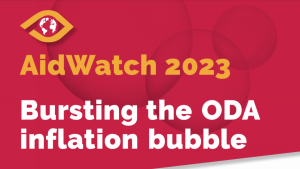 ODA … missing the mark (again): Preliminary 2023 figures show EU aid keeps failing human development and equality
ODA … missing the mark (again): Preliminary 2023 figures show EU aid keeps failing human development and equality
Brussels, 11 April 2024 – Today, the Organisation for Economic Cooperation and Development’s (OECD) Development Assistance Committee (DAC) unveiled early figures for 2023 Official Development Assistance (ODA) spending by donor countries. The numbers reveal donor countries are yet again failing to meet the original objectives of ODA to promote human development and fight inequalities in partner countries.
In 2023, ODA increased to USD 223.7 billion. This represents 0,37% of OECD DAC members’s Gross National Income (GNI) and a weak increase of ODA by 1.8% in real terms compared to 2022. Unfortunately, there is little to celebrate. This so-called rise in EU ODA is largely driven by inflated figures, a trend that was already highlighted in the 2023 AidWatch report.
Last year, aid continued to be inflated by allocating public funds to cover the costs of hosting refugees within donor countries’ borders, referred to by the OECD as in-donor refugee costs. This results in the majority of EU Member States being the recipient of a substantial portion of their own ODA allocations. CONCORD has already highlighted this trend on several occasions, including in April 2023.
Yet the issue persists: in 2023 USD 30,967 billion was allocated to in-donor refugee costs. Although this represents a slight decrease compared to the 31 billion USD allocated in 2022, the share of ODA going to in-donor refugee costs still represents 13,8% of DAC member countries’ total ODA. While hosting refugees is a human rights obligation, donor countries have the financial capacity to fulfil this duty without diverting ODA resources intended to enhance economic development and welfare in partner countries.
“We, civil society organisations, will keep asking for in-donor refugee costs to be completely excluded from the list of ODA-eligible activities to ensure the integrity of ODA. Even though they are necessary and important, these costs do not contribute to the welfare of the people in EU partner countries.”
ODA levels to least developed countries (LDCs) have not recovered from the cuts in 2022. Despite a modest 3% increase in bilateral aid from DAC members to LDCs, it is crucial not to be misled by this figure. The increase of 3% is not comparable to the significant cuts of 6.2% implemented in 2022. DAC members need to substantially improve their support in a global scenario characterised by increasing inequalities, more conflicts, and record-high levels of debt repayment from countries ranking at the bottom of the Human Development Index (HDI). The current aid levels fall short of addressing these urgent challenges.
“Since 2011, external debt owed by Least Developed Countries (LDC) governments has more than doubled, increasing from $144 billion to $344 billion. Around half of this increase is attributed to rising debt owed to multilateral institutions and loans from DAC member countries.”
In 2005, the EU and Member States committed to allocate at least 0.7% of their GNI to ODA by 2015. Since then, CONCORD has held them accountable for their commitment through its AidWatch reports. Nineteen years later, EU donors keep failing to meet the targets and to defend the quality and integrity of ODA by diverting it from its core goals and using it for domestic interests. This contradiction undermines the EU’s credibility globally.
“The EU and Member States don’t seem to understand that influence and trust go hand-in-hand. Part of the reason why the EU is losing geopolitical influence is because partner countries have realised the EU’s promises are empty. Would you side with someone you can’t trust and who puts their own interests first?”
